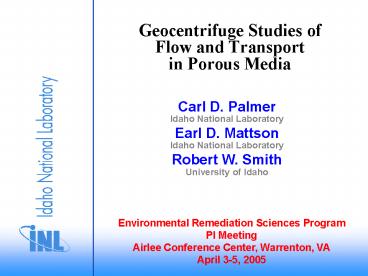Geocentrifuge Studies of Flow and Transport in Porous Media - PowerPoint PPT Presentation
1 / 29
Title: Geocentrifuge Studies of Flow and Transport in Porous Media
1
Geocentrifuge Studies ofFlow and Transport in
Porous Media
Carl D. Palmer Idaho National Laboratory Earl D.
Mattson Idaho National Laboratory Robert W.
Smith University of Idaho
Environmental Remediation Sciences Program PI
Meeting Airlee Conference Center, Warrenton,
VA April 3-5, 2005
2
INL Geocentrifuge
- Actidyn Systemes
- 2-meter radius
- 5-130 g acceleration
3
Motivation for Geocentrifuge
- Decrease the time required to complete an
experiment compared to 1g experiments.
- Obtain spatial scaling real-world problems
according to the acceleration.
- Study a wider range of conditions than is capable
under 1g acceleration.
4
(No Transcript)
5
Accelerations
6
Fluid Potential
Velocity Term
Centripetal Force
Coriolis Term
Gravitational Term
Work-Pressure Term
7
Pressure and Piezometers
8
Pressure and Piezometers
For
For
9
Elevation Head and Hydraulic Head
10
Specific Discharge
11
Specific Discharge
12
Specific Discharge
13
Specific Discharge
14
Non-dimensionalization of theNavier-Stokes
Equation forFlow in a Centrifugal Field
15
Coriolis Effects
Coriolis effects can be ignored if
16
Coriolis Effects
17
Column Design Schematic
18
Columns
19
New Flexible Moisture Probe Design
20
Fraction Collector Designed to withstand High
Accelerations
21
Column Experiments
22
Column Experiments
23
Comparison of 20-g and 1-g Experiments
24
Column Experiments
25
(No Transcript)
26
Capillary BarrierStudies
27
Summary
- Developed theoretical background that serves as a
basis for improved design, interpretation, and
simulation of experiments - fluid potential,
- pressure, pressure head, hydraulic head in
centrifugal field, - specific discharge,
- Coriolis effects,
- Advanced techniques needed to conduct in-flight
sampling and monitoring on the geocentrifuge, - Improved moisture probes,
- fraction collector for geocentrifuge,
- general experimental setups for geocentrifuge
- Conducted experiments that demonstrate that the
geocentrifuge technique is a viable experimental
method for the study of subsurface processes
where gravitational acceleration is important
28
Summary
Key Advantages of Geocentrifuge Approach
- Decrease time required to complete an experiment
compared to 1g experiments.
- Obtain spatial scaling real-world problems
according to the acceleration.
- Study a wider range of conditions than is capable
under 1g acceleration.
29
Coriolis Effects































